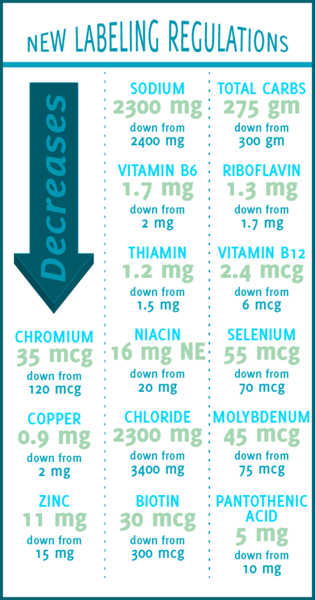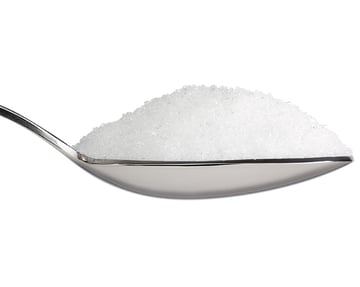With the FDA’s final label ruling, a number of significant changes have been implemented into the Nutrition and Supplement Facts labels, particularly with regard to Daily Value (DV) numbers.
According to the FDA, “Daily values are reference amounts of nutrients to consume or not to exceed and are used to calculate the percent Daily Value (% DV) that manufacturers include on the label.”
Below is a short summary of the nutrients whose DVs have decreased. For a more extensive list of nutrient changes, click here. Check out FDA Nutrition Facts Label Nutrient Changes Part 1 to see the summary of nutrients whose DVs have increased.
Sodium
The DV for Sodium (a mandatory label nutrient) has decreased from 2400 mg to 2300 mg, “a level recommended by leading experts and the overwhelming body of scientific evidence,” the FDA said. According to the research, high sodium intake is associated with high blood pressure, and subsequent risk of heart disease, stroke, and mortality and the FDA, along with the CDC, believe that reducing Americans’ intake of sodium can save thousands of lives.
 Total Carbohydrate
Total Carbohydrate
Total Carbohydrate is another mandatory label nutrient (a macronutrient that includes starch, sugars, sugar alcohols, and fiber) with a new, slightly lower DV. It has decreased from 60 percent of calories to 55 percent of calories for a DV of 275 grams (down from 300 gm) for a 2,000-calorie diet.
The reason for this decrease is to make up for the increase in the DV of total fat — so the percentage of calories contributed by total fat, total carbohydrate, and protein will continue to add up to 100 percent on the label.
Niacin
Niacin is a voluntary nutrient whose label unit is changing from mg of Niacin to mg of Niacin Equivalents (NE). The new unit considers the body’s conversion of the amino acid tryptophan into Niacin and is a more accurate estimation of available niacin in the body. Like Folate and Vitamin E, the new unit for Niacin reflects the current science and takes into account how the vitamin is utilized by the body.
1 mg Niacin Equivalents = 1 mg Niacin = 60 mg tryptophan
Biotin
Biotin is a voluntary nutrient for which the DV has decreased from 300 mcg to 30 mcg. This reflects newer scientific evidence from the Institute of Medicine, which determined that 30 mcg is an adequate intake for Biotin.
The changes for the DVs listed above and others included in the new labeling laws were determined by a variety of scientific studies and reports that the FDA compiled for the new determinations.
Detailed information on the changes can be found in the final rule document here.
Tag(s):
Food Labeling
Other posts you might be interested in
View All Posts
Food Labeling
3 min read
| February 23, 2017
Health Canada’s Nutrition Facts Table Nutrient Changes Part 1
Read More
Product Formulation
3 min read
| June 20, 2016
FDA Nutrition Facts Label Nutrient Changes Part 1
Read More
Food Labeling
3 min read
| February 23, 2017

